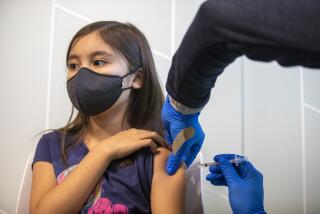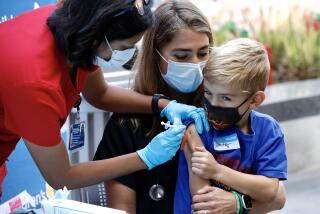New Pains for Adult Survivors of Childhood Cancer
- Share via
Two-thirds of children who are cured of childhood cancer survive only to be afflicted as adults with other severe health problems caused by their treatments, including second cancers, heart problems, mental retardation and blindness, Texas researchers reported.
Overall, survivors are five times as likely to suffer from such problems as their siblings, Dr. Kevin C. Oeffinger of the University of Texas Southwestern Medical Center told a meeting of the American Society of Clinical Oncology in Orlando, Fla., on Monday.
More aggressive and improved treatment regimens have increased the proportion of children whose cancer is cured from 58% in 1975 to more than 75% today. The American Cancer Society estimates that there are about 270,000 survivors of cancer in this country who were diagnosed when they were 15 or younger.
“We have had remarkable success rates when it comes to curing their cancers,” said Dr. Len Lichtenfeld, deputy medical director of the American Cancer Society. “What we haven’t been as good at is analyzing, cataloging and understanding the effects of these treatments.”
The study found that radiation treatment was the most damaging. Radiation to the head can cause retardation and learning disabilities; to the chest, it can cause lung scarring, breast cancer and heart disease; to the abdomen and pelvis, it can cause infertility and loss of sexual functioning.
Chemotherapy drugs also can cause cancer, heart problems, liver failure and sterility. Surgery to remove a brain tumor can cause retardation or other damage.
Researchers were aware of the broad range of problems that could affect young cancer survivors, but this was the first study to show how many of them were actually affected, Oeffinger said.
The study looked at 10,397 adults who were diagnosed with pediatric cancer between 1970 and 1986, along with 3,034 of their healthy siblings. The survivors, treated at one Canadian and 25 U.S. hospitals, were ages 18 to 48 at the time of the study.
By age 45, 57.1% of the survivors -- but only 18.2% of the siblings -- reported moderate health problems, including lung scarring requiring oxygen therapy, congestive heart failure requiring medications, a blood clot in the head or lungs, cirrhosis of the liver, ovarian or testicular failure, or blindness.
By the same age, 37% of survivors and 4.6% of siblings reported severe health problems, including second cancers, heart disease, kidney transplant or dialysis, mental retardation and paralysis of an arm or leg.
Those treated for Hodgkin’s disease were most likely to develop health problems, followed by those treated for brain tumors. Both conditions are typically treated with radiation and chemotherapy.
As the number of survivors grows, physicians need to be more aware of the extent of the problems and provide more effective follow-up care to head off some of the potentially catastrophic health problems, Oeffinger said.
Survivors “need to be followed by someone who is familiar with the risks -- and the vast majority of physicians are not,” he said at a news conference at the meeting.






